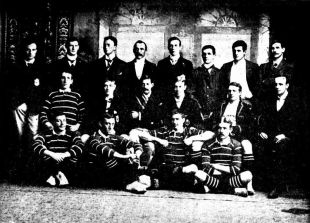|
Australia 13-3 Great Britain, Sydney Cricket Ground
Great Britain run out of steam
Richard Seeckts
June 24, 1899

The 1899 Great Britain side
© Western Mail Enlarge
Australia played their first rugby union international against a team from the British Isles in 1899, later recognised as the first Lions team to Australia. Two tries in the final seven minutes secured a win for the hosts as the British, only twelve days after setting foot in Australia and already playing their fourth match, ran out of steam. The tour was arranged, managed and captained by Reverend Matthew Mullineux, a Blackheath half back. Mullineux dropped himself from the Test team after one match, whereupon the British performance improved markedly and they won the remaining three matches in the series. Initially intended as a touring squad made up Oxford and Cambridge students and internationals from the four home unions, the May 9 departure date prevented many students from taking part. Others were unavailable for such a long tour, notably James Byrne, England full-back and captain who had played all 21 matches on the Great Britain tour of South Africa in 1896. A below-strength party of 21 players, including seven with international experience, embarked on the 21-match tour and returned four months later with 18 wins to their credit. The British team won the first three matches but were out of condition after the sea voyage and, suffering from illness and injury, selection for the first Test largely took care of itself. The XV was identical to that which had beaten New South Wales 4-3 a week earlier. Rev'd Mullineux requested a conference with Australian officials in the days before the match to review differences in the interpretation of the laws of the game from the British way. 28,000 spectators filled the Sydney Cricket Ground, gate receipts totalling £1,200. Australia's first international team comprised nine New South Welshmen and six Queenslanders and this was widely considered their best chance of beating a technically superior opposition lacking practice and fitness, who were expected to improve as the tour progressed. So it turned out. The game was evenly matched at first. Australia scored late in the first half when wing Poley Evans sent a drop-goal attempt wide of the posts. The ball landed in front of British full-back Esmond Martelli who over-ran its irregular bounce while the chasing Australians pounced on the loose ball and scored. Reports vary as to whether Ginger Colton or Alex Kelly touched down first, though there seems little doubt that they chased the kick from an offside position. The British protested that Kelly had interfered with Martelli off the ball, to no avail. Martelli missed a penalty before the break.

The Sydney Cricket Ground played host to the Test
© PA Photos
Enlarge
Welsh centre Gwyn Nicholls' second half try finished off a phase that impressed the United Press Association reporter: "The beautiful series of passes which gained the try for the Englishmen was considered as being an excellent object lesson in backing up. Some of the players, without looking where they were throwing the ball, passed simply because they knew their comrades would be in position to receive it." Martelli missed two more penalty kicks, the second of which almost led to a try when John Francomb, following up, was narrowly beaten to the touchdown by Australian skipper Frank Row. Australia, however, gained the upper hand as the game went on, their forwards playing faster than the British and providing quick ball for their backs to use. With the scores level at 3-3 and seven minutes remaining, Australia finally broke the British defence, Lonnie Spragg finding a gap and touching down in the corner, only to be brought back having put a foot in touch. Spragg did it again immediately, this time scoring midway between the posts and the corner, and adding the conversion. Sensing blood, the Australians stormed back from the restart, kicking downfield and overwhelming Martelli to retain possession. The ball went from Thomas Ward to Evans and on to Spragg who drew in the British defence and passed back for Evans to score under the posts. Spragg's conversion was the last kick of the match. After defeat to Queensland the following week, the tourists found cohesion to match their evident skills and won all bar one of the remaining 15 fixtures. Mullineux's decision to step down in favour of Charlie Adamson proved inspired, Adamson scoring two tries and kicking four conversions and a penalty in the three Test victories that followed. Public interest in Australia waned in line with the results, only 7,000 spectators turning up for the fourth Test. © ESPN Sports Media Ltd.
| |||||||||||||||
Live Sports
Communication error please reload the page.
-
Football
-
Cricket
-
Rugby
-
- Days
- Hrs
- Mins
- Secs
F1 - Abu Dhabi GP
Abu Dhabi Grand Prix December 11-131. Max Verstappen ()
2. Valtteri Bottas (Mercedes)
3. Lewis Hamilton (Mercedes)
4. Alexander Albon ()
5. Lando Norris ()
6. Carlos Sainz Jr ()
-
ESPNOtherLive >>
Golf - Houston Open
Snooker - China Open
Tennis - Miami Open

